November 12, 1981
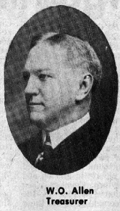
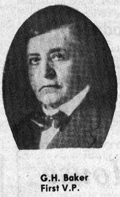
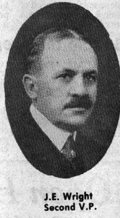
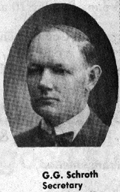
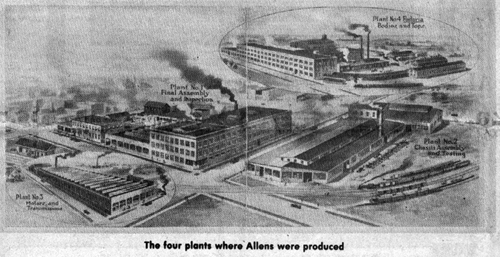
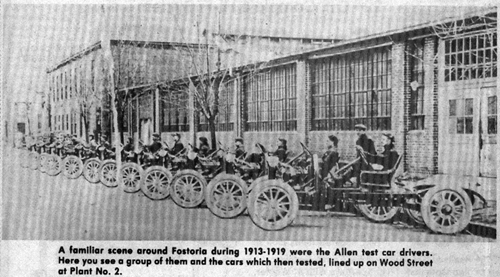
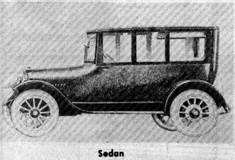
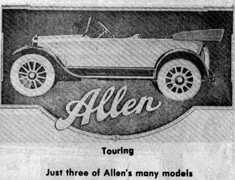
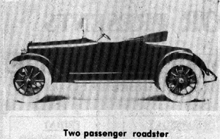
Picture #1 (missing) – E.W. Allen – President
Picture #2 – W.O. Allen – Treasurer
Picture #3 – G.H. Baker – First V.P.
Picture #4 – J.E. Wright – Second V.P.
Picture #5 – G.G. Schroth – Secretary
Picture #6 – The four plants where Allens were produced
Picture #7 – A familiar scene around Fostoria during 1913-1919 were the Allen test car drivers. Here you see a group of them and the cars which they tested, lined up on Wood Street at Plant #2.
Fostoria now has a 1918 model automobile produced by The Allen Motor Co., one of two car manufacturers, one right here in town. The antique Allen will remain in The Fostoria Area Historical Society Museum, having been purchased from William “Bill” Murphy, local Realtor and antique car buff.
Readers who have not already visited the museum to see the old Allen should do so, since today’s article tells the tale of the Allen Motor Co., and the part if played in the town’s industrial scene.
Potluck article of October 30, 1980, told about the Peabody Buggy Co., in a way predecessor to The Allen Motor Co. That article detailed the advent and growth of the buggy and wagon business in our city with Peabody being the largest.
Peabody was headed up by E.W. and W.O. Allen, brothers who contributed much on the industrial scene in Fostoria. When the horseless carriage made its winning bid to replace the horse and buggy, the Allen brothers moved with the trend and planned to switch too.
1913 STARTING DATE
A news item in The Review Daily/Weekly (predecessor to Review Times) of Jan. 6, 1913, announced that Peabody had leased the American Muslin Underwear Co. to make auto parts under the name of Allen Motor Co., and to build a limited quantity of cars that year.
The announcement listed J.E. Wright, who had been with the Columbia Buggy Co., Hamilton, as sales manager of the new company. Frank Blaser, superintendent, and Harry Reinboehl, chief engineer. Peabody and Columbia were said to have had 1,500 buggy dealers, of which 50 percent were already car dealers too; therefore, the limited production of the new Allen Motor Car was considered assured.
The years 1913 through 1915 must have been busy times for all who were engaged with The Allen Motor Co. and exciting for the townspeople as they read in the news columns more stories about the continuing growth of Fostoria’s new industry; the possibility for employment; and witnessed the test drivers buzzing around the streets on car chassis equipped wit only the motors.
HAD FOUR PLANTS
Incidentally, the site of the Anderson Muslin Underwear Co., mentioned earlier, was at the corner of Wood and North Streets, where the YMCA tennis courts and parking lot is now. In more recent years, the A.C. Hoyt Seed Co. building was there, as it was back then acquired by Allen Motor Co. In that building, which became known as Plant No. 1, all final assembly and inspection of the new cars were done.
In the process of further organizing the new company and getting geared up for full production, the Atlas Plant, which occupied all of the area on the west side of Wood Street from Center to North was acquired. That site is where the Post Office is now. The building was then remodeled to accommodate the manufacture of frames and chassis assembly and testing. That plant was known as Plant No. 2
The old Peabody Buggy plant on North Union, the location of Bendix, now was used for the manufacture of bodies and tops and was named Plant No. 4.
Motors and transmissions for the new Allen cars were produced in Bucyrus in a factory owned by L.A. Sommers, who had already been building motors for other car manufacturers. Soon after Allen Motor Co. was organized, Sommers merged his interests with those of Allen. That factory became known as Plant No. 3. Sommers became Allen’s factory manager and chief engineer. In all four facilities for manufacturing. Allen had 250,000 square feet of space.
EXHIBIT AT N.Y. SHOW
The Review published a story in the Jan. 14, 1915, edition which told of the Allen exhibit at the New York Show for Car Manufacturers at Grand Center Palace. In attendance at the show was W.O. Allen, treasurer and general manager; J.E. Wright, sales manager; and L.A. Sommers.
At the show, Allen exhibited the “33” Roadster, “34” Touring, “35” Touring, and “40” Touring cars. W.O. Allen returning from the show, predicted the “34” at $895, would be a big seller. The full line was priced from $875 to $1,395. At that time the company had orders for 3,000 cars and reception at the show was said to be excellent.
Someone in the Allen company, or perhaps in their advertising agency, had appropriately written a poem about the Allen “34” and it was published in The Review:
There are cars that cost but little,
there are cars that cost a pile;
People build some cars for service,
others are built for style;
There are cars of many sizes, large
and medium and small;
Cars that go to beat the dickens, cars that never go at all;
There are homely cars and graceful,
We could name them by the score,
But for niftiness and value, get an
Allen “34”
INGREDIENTS FOR SUCCESS
With excellent knowledge to design and build cars, plenty of well-equipped manufacturing space; and an apparently receptive market, it appeared that the new company would need 400-600 employees to turn out needed volume.
Whereas, The Peabody Buggy Co. had been modest in its organization structure, the Allen organization consisted of many knowledgeable men, in addition to the Allen brothers, J.E. Wright and L.A. Sommers.
Graton H. Baker of The City National Bank of Tiffin was first vice president. Judge George F. Schroth, vice president of City National Bank of Tiffin and president of Sterling Emery Wheel Co., Tiffin, was secretary and legal advisor. Directors were J.A. Thomas, Fostorian involved in manufacturing banking and real estate holdings; George W. Campbell, Toledo, involving in the lumber and insurance field; W.H. Reedy, sole owner of Ready Foundry, Chicago, and stockholder of a Chicago bank; F.F. Prentiss, Cleveland, vice president of Cleveland Twist Drill and active in many other commercial and civic enterprises in that city.
By April 1917, Allen Motor Co., had purchased 70 acres bounded by North, Union, Culbertson and Main Streets, to be developed and known as Allendale. Plans were to remodel the lime kiln plant (the old Fostoria Pressed Steel) to produce sheet metal parts.
There is no evidence that expansion plans for that development were ever completed. According to information I have heard from various Fostorians, The Fostoria Pressed Steel organized in 1917, produced some sheet metal parts for Allen cars, including the frames.
WELL-MADE CARS
According to Bill Murphy, the Allen cars were well designed and built; perhaps too much so, and equally as high in price, to make it impossible to get enough of the market to stay in business. In fact Ford, was making some models which sold for less than $400. Those models did not meet the Allen quality, but they did take a large part of the market. The Allen cars were more in the class of Cadillacs, according to Murphy.
A few of the 1919 Allens were possibly made in Fostoria, but by sometime that year, The Allen Motor Co. was taken over by a group of investors from Columbus, where production of cars continued under the Allen name. L.A. Sommers and his Bucyrus plant was not included in the sale.
A 1919 advertisement in The Saturday Evening Post listed The Allen Motor Co. as Columbus, Ohio, where cars continued to be produced through 1921. The new owners were faced with the same problem…too good, too high priced to sell sufficient volume.
Fostoria’s dream of being a “motor city” had vanished, as well as the job market for both men and women. At another time, Ford Motor Co. had considered Fostoria as a location for a factory, but for reasons which never were published as far as this author knows, it never materialized.
The accompanying photos provide readers glimpses of The Allen Motor Co., its products and nostalgic scenes which some will remember.